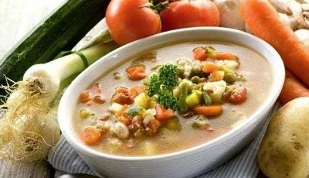
An inflammation of the stomach lining is uncomfortable and painful.
In addition to drug therapy, nutrition is of great importance in gastric gastritis - the "right" products do not irritate the walls, contribute to the regeneration of the epithelium and maintain remission of the disease.
What to eat with gastritis
There are many reasons why gastritis develops:
- Wrong diet with predominantly dry, spicy and hot food;
- Unbalanced diet;
- abuse of alcoholic beverages, soda;
- Taking certain medicines that irritate the stomach lining
Before talking about what to eat with gastritis and what to refuse, there are a few basic postulates of the diet that you need to learn:
- Meals should be regular. You shouldn't take long breaks between meals, miss lunch, or replace afternoon tea with a "double" dinner for any reason.
- With gastritis, fractionated meals are displayed - in small portions at short intervals;
- If possible, do not mix solid and liquid foods. The first courses should be separated from the second courses. Dishes with a liquid or puree-like consistency are the easiest to digest.
- The temperature of food should not be too high or too low. Warm foods are optimally absorbed and do not irritate the stomach.
- The use of table salt should be minimized and spices and condiments should be abandoned entirely.
- The diet should be rich in vitamins, but fiber is too heavy for gastritis patients.
- Dishes are boiled (steamed) or steamed.
What can you eat with gastritis of the stomach
With high acidity
The purpose of the diet against gastritis with increased hydrochloric acid secretion is to lower the acidity and neutralize it with the help of the stomach contents.
- Vegetable soups with noodles, rice. Vegetables are well cooked and passed through a blender;
- Milk soups with noodles or strongly boiled cereals;
- Yesterday (dried) white bread made from wheat flour;
- Meat - beef, lean lamb and pork, chicken, turkey, skinless rabbit, tendons. The meat is baked or steamed, chopped escalopes, casseroles, meatballs, stroganoff (boiled meat) are allowed;
- Milk and non-sour products from it - kefir, yogurt, cream, sour cream, cottage cheese (cheesecake, casseroles), mild types of cheese;
- Chicken, duck, quail eggs - boiled, soft-boiled or in the form of an omelette;
- porridge: semolina, buckwheat, rice, oat flakes, in water or milk, viscous, enveloping, cereals must be boiled down and rubbed through a sieve;
- Vegetables - boiled or steamed, pureed. Pumpkin, squash, potatoes, beets, carrots, cauliflower, rarely tomatoes and peas are allowed;
- Fruit - neutral or sweet, bananas, sweet peeled apples (baked), pears, ripe persimmons. Berries - only sweet, in the form of jelly, compote, fruit drinks, marshmallows, jam, jam;
- Cooked tongue, liver pate, aspic fish, red caviar, milk sausage and doctor's sausage, forshmak, unsalted ham are permitted as cold snacks (in moderation! );
- We recommend drinking sweet compotes, lightly brewed tea (with milk, cream), weak coffee with milk, cocoa, jelly.
- Unsalted butter, ghee and refined vegetable oil are allowed.
Low acidity
The diagnosis should stimulate the production of hydrochloric acid. In contrast to the previous diet, in this case you can:
- Cooking soups in steep fish and meat broths;
- Eat sour vegetables and fruits;
- Include salted canned foods in your diet;
- prefer fermented dairy products;
- Drink sour juices - orange, grapefruit, tomato, grape;
- Drink some mineral water
What not to eat if you have gastritis
With high acidity

- Soups cooked in meat and fish broth, mushroom soups, cabbage soup, borscht, okroshka;
- Fresh bread, pastries, pastries, puff pastry, rye bread and rye flour products;
- fatty meat, poultry, smoked products from them;
- Fatty and salted fish, canned fish;
- sour milk products, spicy cheese;
- Fried eggs and hard-boiled eggs;
- millet, barley, pearl barley, corn porridge;
- noodles, except noodles;
- Legumes, cabbage, rutabagas, beets, sorrel, cucumber, spinach, onions; any vegetable in the form of cucumber, pickled, pickled, canned; Mushrooms;
- Sour fruits - melon, pomegranate, grapes, peaches, citrus fruits, kiwi. Small berry seeds irritate the intestinal walls and are therefore only consumed in processed form. Dried fruits are not recommended;
- chocolate, ice cream;
- Sauces, mustard, pepper, horseradish. Limited to vanillin, cinnamon, dill, parsley, garlic;
- nuts - peanuts, hazelnuts;
- Drink carbonated drinks, strong coffee and bread kvass.
Low acidity
Foods that cause fermentation in the stomach are prohibited:
- milk, cream, sour cream;
- Confectionery, rolls;
- chocolate;
- Radish, garlic.
Opinion on the use of watermelons is controversial: a ripe, sweet watermelon does no harm, but you shouldn't abuse it, as it puts additional stress on the kidneys, increasing the risk of urolithiasis worsening.
Daily menu for gastritis
Despite strict prohibitions, it is possible (and necessary! ) to eat healthy and tasty food even if the gastritis worsens. The recipes are diverse, the main thing is to show your imagination.
Sample menu for the day:
- Breakfast. Buckwheat milk porridge (pureed), scrambled eggs, tea with milk;
- Second breakfast. Kussel, unleavened biscuits;
- lunch. Fish soup with vegetables (in the second broth), beetroot caviar, steamed chicken meatballs, tea with milk;
- afternoon snack. Cottage cheese casserole with sour cream.
- dinner. Vermicelli with fish cakes, rose hip broth;
- Curdled milk for the night.

For gastritis with low acidity, the menu should be varied with fruits and fermented milk products.
During the period of exacerbation and in the first two weeks after the attack is over, strict adherence to the diet (Table 1) is required.
Then you can gradually add additional foods to the diet and carefully monitor your well-being.

































